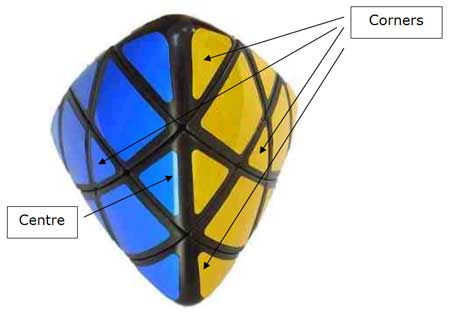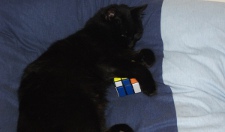Twisting Puzzles
Pillowed Mastermorphix - Hints & Algorithms
Step 1 - Accept That You Are Holding A Cube
The pillowed mastermorphix contains a cube mechanism. It is a cube with odd-shaped pieces. Try to get used to seeing the mastermorphix as a cube - since it is.
The corners and centre piece are labelled in the image below.

Small Triangles & Pyramids are corner pieces. You can swap them around willy-nilly on a cube and can do so on the mastermorphix. This is one of the things that make the puzzle change shape.
Double Triange Pieces are centre pieces. These are sensitive to orientation. If they are twisted by 90°, they poke out.
Trapezium Pieces are the equivalent of the middle edges of a cube. They poke out if they are twisted 180°.
Cube algorithms do what they do on the cube. Some cube pieces (centres) are not sensitive to orientation unless there are pictures on them instead of plain colours. On this puzzle, orientation of the centres matters.
Notation
The main notation for the algorithms is the same as for the cube. Slice moves are particularly helpful as a shorthand in the algorithms. The letters M, S, & E are used.
- M (Middle Layer) - In between R & L - turn in the direction of L.
- S (Standing Layer) - In between F & B - turn in the direction of F.
- E (Equator) - In between U & B - turn in the direction of D
Single Colour
If you have a single-colour version of the puzzle or just want to return the 4-colour puzzle to its original shape, you can be a little free and easy.
You can go for a cross, first two layers, orient, permute approach. You might as well not bother with this though. If you swap the corners around a little so that you alternate the large and small corners, you will be nearly there. Rotate the slices until the puzzle is as close to solved as you can get it. There will most likely be a couple of twisted edges and some twisted centres.
Edges
The main algorithm I use for untwisting edges on the cube works well in the mastermorphix - there is a lot of repetition to help you keep track of what you are doing. Untwist the two edges on the R face by using the algorithm below,

E R' E R' E R2 E' R' E' R' E' R2
Sometimes the edges you want to twist are not next to each other like you see in the cube image. The algorithm doesn't affect any other pieces - so you can do whatever you need to place the edges next to each other. Just undo it after you have executed the algorithm.
Centres
On the single colour version, the centres are a problem if they are out by 90° - otherwise you wouldn't notice. The following table of algorithms will let you do 90° twists of centres.
| Face Centres To Twist | Algorithm |
|---|---|
| U+ L+ | M E M' U' M E' M' U' |
| U+ | R' U R U' F' U' F |
The second algorithm is only any use on this puzzle. It relies on the fact that on the single colour version, many of the pieces can be swapped without changing the solved state of the puzzle. Try this on a cube - it does rotate the centre (you can see this happen if it's marked) but swaps a whole load of other pieces around.
4-Colour
You need to work a bit harder to solve the multi-coloured version of the mastermorphix. Start as you would for the cube by making a cross and then solving the middle layer. I use the absolute beginner's approach here to avoid getting confused by the shapes of the pieces. Make the first layer as shown in the image and then slot in the middle layer edges.

You can try to twist all of the centres into position at this stage. I can never make sure that I don't use moves which twist them back again so I leave the centre rotation until the end.
Parity
You might find that your last layer algorithms don't quite do what you expect. You may be struggling to get edges or corners to cycle as they should. This is a common problem when puzzles have pieces which are sensitive to orientation on a cube but not on the puzzle. In this case, centres and little corners can be twisted without it being obvious. Try twisting a couple of the little corners and then have another go at the last layer. If all else fails, concentrate on positioning of corners and edges. You can leave the orientation of edges until the end and can use the algorithm for untwisting edges that is shown earlier on this page.
Centres
The following algorithms are useful for rotating centre pieces. Note that you will not be able to do a single centre rotation - if you are left with that situation then you have a parity issue. With the 4-colour version, a centre can be 180° out.
| Face Centres To Twist | Algorithm |
|---|---|
| U+ L+ | M E M' U' M E' M' U' |
| U++ | U R L U2 R' L' U R L U2 R' L' |
| U++ D++ | U2 R2 S2 L2 D2 R2 S2 L2 |

